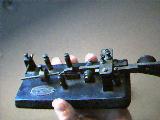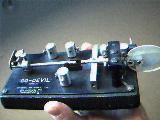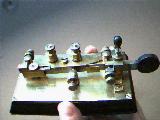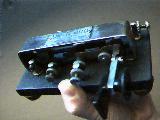More Bugs from the 1920's and 1930's

 |
 |
| 1933 Model Go-Devil | 1950's Model Go-Devil |
The Go-Devil was made by A.H. Emery of Poughkeepsie, N.Y.,
beginning in 1933. The model on the left was the earlier one, the model
on the right quite a bit later, thought to be 1950's vintage. With the
vibrating lever arm locked at the damper, the Go-Devil can function as a
sideswiper.

This is the Gold Bug, made by J.H. Bunnell in 1922. It came in several
variations, mainly the presence or absence of a label and the type of fingerpiece.
The Gold Bug here has a "lollipop" type fingerpiece and no label, just the
manufacturer's name and SN 116 stamped into the bare area in the lower
left corner of the picture in very small letters. The Gold Bug precipitated
a lawsuit between Vibroplex and Bunnell. Vibroplex contended that it had
exclusive rights to the word "bug." The courts decided otherwise!
Systems that couple (or "match") a transmitter to the line are called antenna tuners, or
transmatches. They don't really "tune" an antenna, but match the transmitter to the load. From a
more practical standpoint, they bring down the SWR of an antenna system to as low as
possible. The most common form of antenna tuner uses two variable capacitors and a tapped
inductor, as above. When adjusting an antenna tuner, always use the lowest power that will register
on the meter. In the box above, we have a "virtual transmatch" in the top half and the diagram
of the transmatch in the bottom half of the box. Imagine that you have a wire antenna attached
to one side of the transmatch, and your transmitter to the other. Try adjusting the transmatch
for minimum SWR. Usually you would start by adjusting the inductor to the best received
signal and then adjusting the two capacitors for SWR minimums. With our virtual transmatch, you'll
have to do a little experimenting with different inductances and capacitances. To change inductance,
just click on a different letter for a different tap. To change the capacitances, click on
the capacitor you wish to vary, then move your mouse right or left underneath it. Click again
to stop. Good luck, it is possible to get a perfect match with the virtual transmatch!

This Simplex Auto is a right-angle bug which outwardly looks reminiscent
of the Mecograph. The Simplex Auto was made by Leo Cohen in Melbourne,
Australia. The Mecograph was also available in Australia and perhaps influenced
the design of Cohen's bug. In 1923 the Simplex Auto was adopted by the
Postmaster General's Department as a standard sending aid for the Commonwealth
of Australia. This particular bug was used for 50 years on the postal
telegraph circuit in Australia. In Australia, "bugs" are known as "jiggers."
The key element in a telephone is the carbon granule in the microphone.
The electrical resistance of carbon varies under pressure. When
sound waves strike the diaphragm, it puts a varying pressure on the
carbon and causes the current to vary in the line. Adapted from Maver's
American Telegraphy and Encyclopedia of the Telegraph.

 Back to the Index
Back to the Index
 On to more bugs!
On to more bugs!







 Back to the Index
Back to the Index
 On to more bugs!
On to more bugs!